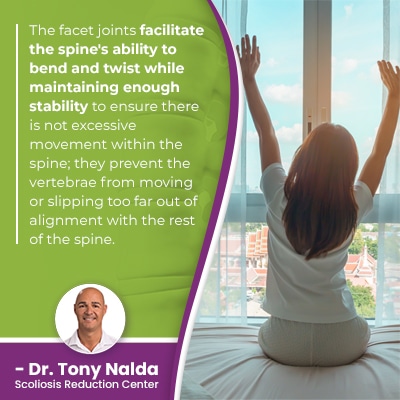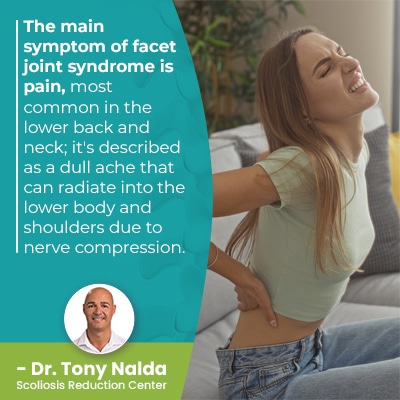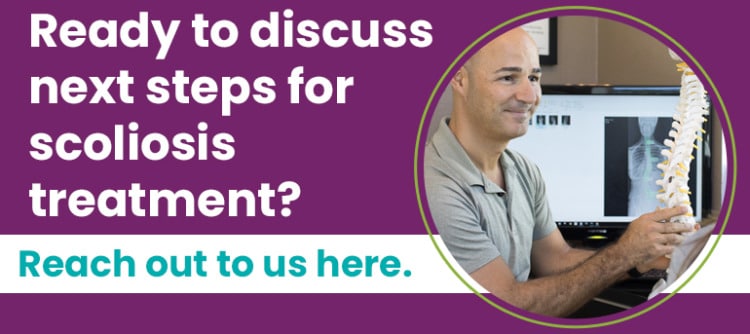Facet Joint Syndrome: Causes, Symptoms, and Treatments

The spine is a complex structure containing many moving parts. The facet joints provide the spine with structure by connecting its vertebrae, and if a facet joint deteriorates, it can cause excessive movement within the spine, disrupting its alignment and stability.
Facet joint syndrome is also known as facet joint disease and involves the facet joints of the spine facing degenerative changes that can cause pain. The most common causes of facet joint syndrome include degenerative changes, an underlying spinal condition, and injury.
The stability of the spine is based on how well its individual parts function, including the facet joints.
Table of Contents
Facet Joints
In a healthy spine, its vertebrae are stacked on top of one another in a straight and neutral alignment, and it's curved at each of its mean sections.
Adjacent vertebrae are separated by an intervertebral disc, and disc health shapes spinal health as they give the spine structure, flexibility, provide cushioning between vertebral bodies, and act as the spine's shock absorbers.
Degenerative disc disease is a contributing factor in the development of a number of spinal conditions/issues.
The spine's healthy curves are also key to its biomechanics, and for the spine to maintain its natural curves and alignment, its discs, vertebrae, and facet joints need to be healthy and functional.
Facet joints are small joints located on each side of a vertebral body and connect to the vertebrae above and below.
Facet Joints: Motion and Structure
 The facet joints facilitate the spine's ability to bend and twist while maintaining enough stability to ensure there is not excessive movement within the spine; they prevent the vertebrae from moving or slipping too far out of alignment with the rest of the spine.
The facet joints facilitate the spine's ability to bend and twist while maintaining enough stability to ensure there is not excessive movement within the spine; they prevent the vertebrae from moving or slipping too far out of alignment with the rest of the spine.
The facet joints link the vertebrae together and form a functioning unit with adjacent vertebrae and the disc that sits between: what's known as a motion segment.
The motion segments allow for structure, strength, flexibility, and coordinated movement.
The facet joints are synovial joints, meaning they contain a capsule of synovial fluid that facilitates smooth gliding motion of the joints and spine.
The joints enable bending forward, backwards, and twisting motions.
If facet joint syndrome develops, the facet joints are degenerating, damaged, and/or inflamed, and can become a source of discomfort.
Facet Joint Syndrome Causes
The main cause of facet joint syndrome is natural wear and tear on the spine that can occur over time.
Osteoarthritis of the spine can cause the cartilage that protects the joints to wear out, causing friction when vertebrae rub together.
An injury from a fall or car accident can also damage the facet joints, and spinal conditions like spondylolisthesis can also cause facet joint syndrome as it involves a vertebral body slipping out of alignment with the rest of the spine and onto the vertebrae below, exposing it to uneven forces.
A number of lifestyle factors also shape the spine's general health and can impact the health of the facet joints.
Carrying excess weight strains the facet joints and can lead to early degenerative changes and the development of degenerative disc disease.
Excessive smoking is also associated with disc desiccation, degeneration, and poor spinal health.
Chronic poor posture introduces adverse spinal tension, and over time, can also affect the position of vertebral bodies and disrupt the spine's healthy structure.
Symptoms of Facet Joint Syndrome
Facet joint syndrome can cause different symptoms based on cause, location of the affected joints, and severity.
Age is a factor as well when it comes to spinal degeneration.
 The main symptom of facet joint syndrome is pain, most common in the lower back and neck; it's described as a dull ache that can radiate into the lower body and shoulders due to nerve compression.
The main symptom of facet joint syndrome is pain, most common in the lower back and neck; it's described as a dull ache that can radiate into the lower body and shoulders due to nerve compression.
When a vertebral body or disc changes shape and/or moves, it can compress the spinal nerves within, causing radiating pain and a number of issues.
Excessive stiffness in the back is another symptom, particularly upon waking and/or being inactive for long periods of time.
Disruptions to movement are also common as the smooth gliding motion of the joints and spine is affected, so bends and twists can be particularly difficult and painful.
Back pain will also worsen with certain movements such as bending backward, twists, and after being still for long periods.
Movement like bending forward, changing positions, and sitting can help ease facet joint syndrome pain.
Facet Joint Syndrome Treatment Options
There are a number of treatment options available to ease the symptoms of facet joint syndrome, including self care with hot/cold therapy, rest, over-the-counter pain medications and gentle stretching exercises.
I can help patients with lifestyle guidance when there is room for improvement; leading a spine-friendly lifestyle can help preserve spinal function and prevent early and excessive levels of degenerative changes in the spine.
Physical Therapy
Physical therapy is a common form of treatment that focuses on improving the spine's surrounding muscle strength as this can mean more support for the spine and can take pressure off the facet joints.
Increasing spinal flexibility is another goal of physical therapy that can help preserve the spine's natural flexibility and range of motion, and this also helps reduce pain by counteracting the stiffness caused by the facet joint syndrome.
Physical therapy can also help improve circulation around an affected facet joint and disc to help with disc degeneration; discs don't have their own vascular supply so have to absorb oxygen and nutrients from its surroundings.
Medication
Medications can help with muscle pain, back and nerve pain, and in some cases, corticosteroid injections can help reduce inflammation and pain.
Nerve ablation is a procedure that applies intense heat to a damaged nerve causing pain, and in some cases, surgical intervention is recommended to repair damage and restore function.
Bracing and Postural Assessment
While not a common form of treatment for facet joint syndrome, I can also prescribe corrective bracing for short-term pain relief and improvements to stability.
Postural assessment is a key focus of my patient assessment for a number of spinal conditions/issues; healthy posture is undervalued, and I can tell a lot about the health of a patient's spine by how they move and hold their bodies.
By improving posture through awareness and retraining, the spine's alignment can be improved and maintained and also helps ensure the spine's not being exposed to uneven forces that can contribute to degenerative changes.
Health posture means knowing how to best position the spine and body during movement and daily activities, and with the prevalence of screen use in the modern age, the value of good posture is being lost, but the effects of poor posture are being felt.
Conclusion
Facet joint syndrome can cause facet joint pain that can range from mild to a chronic dull ache, to nerve pain that radiates throughout the body.
The spine's facet joints provide structure, flexibility, and support, and when they deteriorate, this can cause pain as vertebrae rub together and experience friction during movement.
As the facet joints facilitate forward and backward bends and rotation, movement can also be disrupted, and this can contribute to weak core muscles.
When the spine isn't surrounded by strong supportive muscles, the spine's individual structures are more strained as they have to maintain the spine's healthy curves and alignment.
Facet joints syndrome treatment options have the goal of reducing pain, taking pressure off the joints, and improving the spine's support and stability through strengthening its surrounding muscles.
Physical therapy can work towards strengthening the spine's surrounding muscles, improving the spine's flexibility, posture, and reducing pain.
When lifestyle factors can be improved, lifestyle guidance is important, and I work closely with patients to help them establish a spine-friendly lifestyle that can help improve quality of life and facilitate long term relief.
Here at the Scoliosis Reduction Center®, I want my patients to have awareness and guidance. I don't want to just treat their conditions and send them on their way. Through lifestyle guidance and awareness, I want to empower patients with the knowledge of how they can preserve spinal health and function.
So don't hesitate to reach out if you, or someone you care about, is experiencing unexplained back pain; a postural assessment, physical examination, and X-ray results, when necessary, can help diagnose and treat facet joint syndrome for improvements to quality of life and long term relief.
Dr. Tony Nalda
DOCTOR OF CHIROPRACTIC
After receiving an undergraduate degree in psychology and his Doctorate of Chiropractic from Life University, Dr. Nalda settled in Celebration, Florida and proceeded to build one of Central Florida’s most successful chiropractic clinics.
His experience with patients suffering from scoliosis, and the confusion and frustration they faced, led him to seek a specialty in scoliosis care. In 2006 he completed his Intensive Care Certification from CLEAR Institute, a leading scoliosis educational and certification center.
About Dr. Tony Nalda
 Ready to explore scoliosis treatment? Contact Us Now
Ready to explore scoliosis treatment? Contact Us Now





